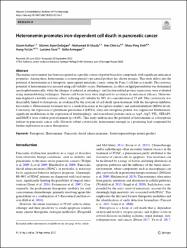Heteronemin promotes iron-dependent cell death in pancreatic cancer

Göster/
Erişim
info:eu-repo/semantics/embargoedAccessTarih
2023Yazar
Kaftan, GizemErdoğan, Mümin Alper
Shazly, Mohammed El
Chin Lu, Mei
Ping Shih, Shou
Yu Lin, Hung
Saso, Luciano
Armağan, Güliz
Üst veri
Tüm öğe kaydını gösterKünye
Kaftan, G., Erdoğan, M. A., El-Shazly, M., Lu, M. C., Shih, S. P., Lin, H. Y., ... & Armagan, G. (2023). Heteronemin promotes iron-dependent cell death in pancreatic cancer. Naunyn-Schmiedeberg's Archives of Pharmacology, 1-10.Özet
The marine environment has been recognized as a prolific source of potent bioactive compounds with significant anticancer properties. Among these, heteronemin, a sesterterpenoid-type natural product, has shown promise. This study delves into the potential of heteronemin as a ferroptotic agent against pancreatic cancer, using the Panc-1 cell line as a model. The cytotoxic potential of heteronemin was assessed using cell viability assays. Furthermore, its effect on lipid peroxidation was determined spectrophotometrically, while the changes it induced in autophagy- and ferritin-related protein expressions were evaluated using immunoblotting techniques. Various cell-based tests were employed to scrutinize its anticancer efficacy. Heteronemin displayed a notable cytotoxic effect, reducing cell viability by 50% at a concentration of 55 nM. This cytotoxicity was discernibly linked to ferroptosis, as evidenced by the reversal of cell death upon treatment with the ferroptosis inhibitor, ferrostatin-1. Heteronemin treatment led to a marked increase in ferroptosis markers and malondialdehyde (MDA) levels. Conversely, the expression of glutathione peroxidase-4 (GPX4), a key anti-ferroptotic protein, was suppressed. Furthermore, significant modulations in the expression of ferritinophagy- and iron-related proteins such as Atg5, Atg7, FTL, STEAP3, and DMT-1 were evident post-treatment (p < 0.05). This study underscores the potential of heteronemin as a ferroptosis inducer in pancreatic cancer cells. Given its robust cytotoxicity, heteronemin emerges as a promising lead compound for further exploration in cancer therapeutics.















